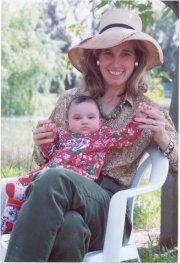
Mother and Scientist who Evolved
Sarah Blaffer Hrdy
Sarah Blaffer Hrdy is an anthropologist and sociobiologist famous for her studies of motherhood and group dynamics in primates. Her major contributions connect research on nonhuman primates to humans. She is particularly noted for her theories on infanticide and female sexual strategies.
While pursuing her PhD, Hrdy investigat the evolutionary causes infanticide among the langurs of Mount Abu, India. Her 1977 book, The Langurs of Abu: Female and Male Strategies of Reproduction, was controversial. Rather than treating infanticide as pathological behavior triggered by overcrowding, Hrdy proposed that infanticide was an adaptive strategy beneficial to the males practicing it. When outside male langurs take over a preexisting group, they may kill unweaned young thereby causing the females to again ovulate sooner because they no longer have suckling young. Infanticide thus increases the reproductive success of males albeit at the expense of mothers, infants, and the male predecessors.
Hrdy also hypothesized that female primates developed counterstrategies against infanticide including situation-dependent sexual receptivity and solicitation of multiple male partners. Since males almost never attack offspring they might have sired, a mother may protect offspring by manipulating information available to males about paternity. Far from passive bystanders, mothers are active agents in determining their lifetime reproductive success.
In her 1999 book, Mother Nature: a History of Mothers, Infants and Natural Selection, Hrdy explored what “maternal instincts” actually mean. She pointed out that all mammalian females have innate maternal responses, but this does not mean that a mother automatically nurtures every offspring she produces or does so with the same level of commitment. In humans, initial maternal commitment depends on a range of factors especially perception of social support. There was no way, she argued, that a relatively larger brained bipedal ape, producing offspring as costly and dependent for so long as those in the genus Homo could have evolved had mothers not had help caring for and provisioning them, what became known as “the cooperative breeding hypothesis”.
In a subsequent book, Mother and Others: the Evolutionary Origins of Mutual Understanding (2009), Hrdy examined the effects on developing humans of their prolonged dependence on alloparents (group members other than genetic parents) in addition to parents. Over the course of development, already clever, manipulative little apes with rudimentary theory of mind became conditioned to read the intentions of others, appeal to them, and elicit their solicitude, thus producing novel ape phenotypes. These more “other regarding” ape youngsters were in turn subjected to directional Darwinian selection favoring those just a little better at reading the mental states of others. These would be the youngsters most likely to be cared for and fed, and thus survive. The emergence of apes interested in the thoughts and feelings of others and eager to attract and to ingratiate themselves with these others, laid the cognitive and emotional foundations for such distinctively human capacities as language and morality. In this way, she argued, without any foresight on the part of “Mother Nature” (her metaphor for Darwinian natural selection), regarding the eventual benefits of an improved ability to read the intentions of others and work with them towards joint goals, the peculiar mode of child-rearing in the line of apes leading to Homo sapiens served as “the prequel” to the “main human feature film”.
Hrdy’s work dismantled traditional views of motherhood and gender roles. Her studies of motherhood in primates illuminated the many things humans have in common with our relatives, as well as the ways in which we evolved. (Photo courtesy of Sarah Blaffer Hrdy, photographer is Dr Anula Jayasuriya, child is the photographer’s daughter, Shanika.)